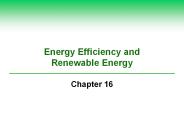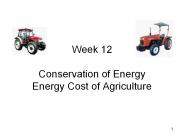Light Energy Harvesting System PowerPoint PPT Presentations
All Time
Recommended
Energy harvesting is a process through which energy derived, stored and managed to be used for viable purposes. It is defined as the process of converting ambient energy into electrical energy. This ambient energy can be used during demand hours, to supply power to off-grid remote areas.
| PowerPoint PPT presentation | free to download
Avail more information from Sample Brochure of report @ http://tinyurl.com/j9yev4t 2016 Global Light Energy Harvesting System Industry, focusing on the main regions (North America, Europe and Asia) and the main countries (United States, Germany, Japan and China). Then it analyzed the world's main region market conditions, including the product price, profit, capacity, production, capacity utilization, supply, demand and industry growth rate etc. In the end, the report introduced new project SWOT analysis, investment feasibility analysis, and investment return analysis. Read analysis @ http://tinyurl.com/hlxg579
| PowerPoint PPT presentation | free to download
Energy harvesting is the procedure in which energy is gained from a system’s environment and converted into working electric power. Energy harvesting is also called as power harvesting or ambient power or energy scavenging.
| PowerPoint PPT presentation | free to download
The global energy harvesting systems market is estimated to grow at a CAGR of 12.1% during the forecast period, 2021-2026, and shall cross $1 billion mark by 2026, from around $615 million in 2020. Energy harvesting devices help in energy conservation in Power Management Integrated Circuits (PMIC) which are been dissipated in terms of heat, electromagnetic radiation, light, sound, vibration, or movement. Devices aids in harvest or energy scavenging can capture, accumulate, store, condition, and manage this energy into electricity for further consumption.
| PowerPoint PPT presentation | free to download
The global energy harvesting systems market is estimated to grow at a CAGR of 12.1% during the forecast period, 2021-2026, and shall cross $1 billion mark by 2026, from around $615 million in 2020. Energy harvesting devices help in energy conservation in Power Management Integrated Circuits (PMIC) which are been dissipated in terms of heat, electromagnetic radiation, light, sound, vibration, or movement.
| PowerPoint PPT presentation | free to download
The global energy harvesting systems market is estimated to grow at a CAGR of 12.1% during the forecast period, 2021-2026, and shall cross $1 billion mark by 2026, from around $615 million in 2020.
| PowerPoint PPT presentation | free to download
The phenomenon of Resonance Energy Transfer (RET) Light harvesting in nature ... They are on distances sufficient for Forster RET ...
| PowerPoint PPT presentation | free to view
Energy harvesting system is the technology that converts the energy from the environment in to usable electric power. This system extracts small amounts of energy from the environment that otherwise have been lost in the form of heat, light, sound or vibration. This process is also known as energy scavenging and is widely used in consumer devices, medical industry, and transportation, military and so on. It is an environmental friendly way of converting energy into electrical power.
| PowerPoint PPT presentation | free to download
According to the latest research report by IMARC Group, The global energy harvesting system market reached a value of US$ 425.7 Million in 2021. Looking forward, IMARC Group expects the market to reach US$ 867.4 Million by 2027, exhibiting at a CAGR of 12.8% during 2022-2027. More Info:- https://www.imarcgroup.com/energy-harvesting-system-market
| PowerPoint PPT presentation | free to download
The market is segmented on the basis of application into building & home automation, industrial, transportation infrastructure, railways, aerospace, automotive, and security. The building and home automation segment is expected to hold the leading position by 2022 in the energy harvesting for wireless sensor network market. The growth of the building and home automation application is prominent in North America and Europe owing to the growing adoption of smart homes and also that of energy harvesting systems.
| PowerPoint PPT presentation | free to download
This report studies the global Energy Harvesting System market size, industry status and forecast, competition landscape and growth opportunity. This research report categorizes the global Energy Harvesting System market by companies, region, type and end-use industry.
| PowerPoint PPT presentation | free to download
Looking forward, the energy harvesting system market value is projected to reach a strong growth during the forecast period (2022-2027). More info:- https://www.imarcgroup.com/energy-harvesting-system-market
| PowerPoint PPT presentation | free to download
Rise in the demand for power efficient and durable systems has led to the rise in demand for energy harvesting systems. Data Bridge Market Research analyses that the energy harvesting system market will exhibit a CAGR of 10.04% for the forecast period of 2021-2028.
| PowerPoint PPT presentation | free to download
Energy harvesting system is the technology that converts the energy from the environment in to usable electric power. This system extracts small amounts of energy from the environment that otherwise have been lost in the form of heat, light, sound or vibration. This process is also known as energy scavenging and is widely used in consumer devices, medical industry, and transportation, military and so on. It is an environmental friendly way of converting energy into electrical power.
| PowerPoint PPT presentation | free to download
Global Energy Harvesting System Market is expected to rise from its initial estimated value of USD 381.7 million in 2018 to an estimated value of USD 863.91 million by 2026, registering a CAGR of 10.75% in the forecast period of 2019-2026. This rise in market value can be attributed to the increasing demand for durable and power efficient systems.
| PowerPoint PPT presentation | free to download
Global Energy Harvesting System Market is expected to rise from its initial estimated value of USD 381.7 million in 2018 to an estimated value of USD 863.91 million by 2026, registering a CAGR of 10.75% in the forecast period of 2019-2026. This rise in market value can be attributed to the increasing demand for durable and power efficient systems.
| PowerPoint PPT presentation | free to download
Learn about Solar MPPT (Maximum Power Point Tracking) Controllers and how they improve the efficiency of solar power systems. Improve your solar system's energy efficiency and power production using modern MPPT technology.
| PowerPoint PPT presentation | free to download
The energy harvesting global market is anticipated to rise from $ 1276 million in 2016 to $ 6255 million by 2024. The market is expected to grow at a CAGR of 22.21% between 2017 and 2024
| PowerPoint PPT presentation | free to download
Building tomorrows energy system
| PowerPoint PPT presentation | free to download
Energy Efficiency and Renewable Energy Chapter 16 * * Figure 16.32 Solutions: decentralized power system in which electricity is produced by a large number of ...
| PowerPoint PPT presentation | free to download
Cellular Respiration Harvesting Chemical Energy Chapter 9 Living is work Cells require transfusions of energy from outside sources to perform work Ecosystems, energy ...
| PowerPoint PPT presentation | free to view
Chapter 17 Energy Efficiency and Renewable Energy * Figure 17.37 Individuals matter: ways to reduce your use and waste of energy. * * Figure 17.21 Solutions: wind ...
| PowerPoint PPT presentation | free to download
Energy Efficiency and Renewable Energy
| PowerPoint PPT presentation | free to view
Chapter 16 Energy Efficiency and Renewable Energy
| PowerPoint PPT presentation | free to view
Solar Energy Systems ... Very difficult terrain - few roads ... mains grid electricity is not available Typical SHS has a 20-85w PV panel, solar deep cycle ...
| PowerPoint PPT presentation | free to view
Chapter 17 Energy Efficiency and Renewable Energy Chapter Overview Questions How can we improve energy efficiency and what are the advantages of doing so?
| PowerPoint PPT presentation | free to view
How Cells Harvest Chemical Energy Alcoholic Fermentation Reactions cannot be reversed. Remember, the lactate fermentation reaction is reversible Lactate can be ...
| PowerPoint PPT presentation | free to view
Cellular respiration releases the energy stored in glucose in a series of steps ... in two ways during cellular respiration: Substrate level phosphorylation ...
| PowerPoint PPT presentation | free to view
How Cells Harvest Chemical Energy Alcoholic Fermentation Reactions cannot be reversed. Remember, the lactate fermentation reaction is reversible Lactate can be ...
| PowerPoint PPT presentation | free to view
Core Case Study: The Coming Energy-Efficiency and Renewable-Energy Revolution ... Need access to sun most of the time. Fast construction (1 2 years) High land use ...
| PowerPoint PPT presentation | free to view
Energy harvesting Market devices are evolving in the context of the development of solid state technology that provides vast improvements. Improvements in energy density are one of the benefits of energy harvesting give to traditional rechargeable and solid state batteries. Energy harvesting Market technologies include electrodynamics, photovoltaics, piezoelectrics, and thermovoltaics. Photovoltaic systems for solar energy is mostly outside the scope of this study. The energy harvesting and energy storage market factors light harvesting for small devices Source@ http://www.marketresearchstore.com/report/energy-harvesting-market-shares-strategies-and-forecasts-worldwide-2395
| PowerPoint PPT presentation | free to download
Global energy harvesting market is expected to reach $1894.87 million by 2017, at an estimated CAGR of 24.31%. Europe is leading the total energy harvesting technology market; followed by North America and APAC. In the market of ROW, Middle East, and Africa are the largest contributors.
| PowerPoint PPT presentation | free to download
The coupling of ATP synthesis to electron transport via a concentration gradient. ... Muscle cells produce lactic acid. Only a 2 ATP are produced per glucose ...
| PowerPoint PPT presentation | free to view
Harvesting Solar Energy in Western North Carolina
| PowerPoint PPT presentation | free to view
The role of carotenoids as accessory pigments and in photoprotection of chlorophyll and ... accepting electrons from PSI, they auto-oxidize and reduce oxygen to ...
| PowerPoint PPT presentation | free to view
Glycolysis. Aerobic Cell Respiration. Anaerobic Cell Respiration. O2 ... Requires NADH generated by glycolysis. Where do you suppose these reactions take place? ...
| PowerPoint PPT presentation | free to view
RENEWABLE FORMS OF ENERGY LES ENERGIES RENOUVELABLES SOLAR ENERGY L ENERGIE SOLAIRE Advantages of solar energy Avantages de l Energie Solaire A decentralised form ...
| PowerPoint PPT presentation | free to download
POWER MANAGEMENT FOR SUSTAINABLE ENERGY SYSTEMS Graham Town Electronic Engineering Macquarie University. * * * * * * OVERVIEW The need for decreasing reliance on ...
| PowerPoint PPT presentation | free to view
Choose the best hydroponic lights for your grow system. Visit pakenhamhydroponics.com.au to browse for all types of hydroponics lights
| PowerPoint PPT presentation | free to download
Nanoscience and nanotechnology for advanced energy systems Two uses of NS and NT for advanced energy systems Make non-sustainable systems more effective, cleaner, and ...
| PowerPoint PPT presentation | free to download
Cellular Respiration: How Cells Harvest Chemical Energy Chapter 6 * * * * * * * * * * * Plants undergo alcoholic fermentation. A plant makes ethyl alcohol, when there ...
| PowerPoint PPT presentation | free to view
The global energy harvesting market is anticipated to rise with a CAGR of 10.15% and is expected to rise to a revenue of about $ 9.45 billion by the year 2028.
| PowerPoint PPT presentation | free to download
Big Market Research added a report on "Energy Harvesters: Market Shares, Strategies, and Forecasts, Worldwide, 2013 to 2019" Access The Complete Report On : http://www.bigmarketresearch.com/energy-harvesters-shares-strategies-and-forecasts-worldwide-2013-to-2019-market Energy Harvesters markets at $131.4 million in 2012 are projected to increase to $4.2 billion in 2019. Growth is anticipated to be based on demand for micro power generation that can be used to charge thin film batteries. Systems provide clean energy that is good for the environment. Growth is based on global demand for sensors and wireless sensor networks that permit control of systems.
| PowerPoint PPT presentation | free to download
Week 12 Conservation of Energy Energy Cost of Agriculture
| PowerPoint PPT presentation | free to download
Global energy harvesting market is expected to reach $1894.87 million by 2017, at an estimated CAGR of 24.31%. Europe is leading the total energy harvesting technology market; followed by North America and APAC. In the market of ROW, Middle East, and Africa are the largest contributors.
| PowerPoint PPT presentation | free to download
EE535: Renewable Energy: Systems, Technology & Economics Session 4: Solar (1): Solar Radiation Solar Radiation Annual solar radiation on a horizontal surface at the ...
| PowerPoint PPT presentation | free to view
The Mechanisms of Photosynthetic Light Harvesting and. Non-Photochemical Quenching ... 2-3 Bchl a. The Disorder-Exciton-Redfield model. Delocalized states ...
| PowerPoint PPT presentation | free to view
新範式能源技術與地理- 社會- 經濟影響 / The New Paradigm on Energy Technology with Geo-socio-financial Impact. Part 1 of 9 series: Entire part 1 to 9 can be viewed at https://issuu.com/newnatureparadigm/docs/energy_2017-july11 or less controversial version at https://issuu.com/newnatureparadigm/docs/linkedin_aug02新範式能源技術與地理- 社會- 經濟影響 / The New Paradigm on Energy Technology with Geo-socio-financial Impact. Part 1 of 9 series: Entire part 1 to 9 can be viewed at https://issuu.com/newnatureparadigm/docs/energy_2017-july11 or less controversial version at https://issuu.com/newnatureparadigm/docs/linkedin_aug02
| PowerPoint PPT presentation | free to download
... q 0 0 0 0 0 0 0 0 0 0 0 r r r r r r r r r r r r r r r r r r r r r r r r r r r r ... rrrrrrrrrrrrrrrrrrrrrrrrrrrar rGrprSrsr rtrFrTrOrdrrfrerrr rrrrr rr rr rrnr rr ...
| PowerPoint PPT presentation | free to view
1- Leader renewable energy resources. 2 ... Flashed Steam Plants ... Flashed Steam Plants. Constant (capacity factor over 90%) 10 25 (elect.) 35.00 120.0 ...
| PowerPoint PPT presentation | free to view
Uusi paradigma energian teknologia, joka voi vaikuttaa geo - sosiaalis - taloudelliset tilanteet / The new paradigm on energy technology with geo-socio-financial impact.
| PowerPoint PPT presentation | free to download
... unreliable but unlimited energy sources like scavengers (or energy harvesters) Re-think power management for environmentally powered devices ...
| PowerPoint PPT presentation | free to view
Energy Savings Impacts of the Advanced Energy Design Guide: Small Office Buildings Bing Liu, P.E. Research Engineer Pacific Northwest National Laboratory
| PowerPoint PPT presentation | free to view
(Polski podsumowanie) Nowy paradygmat technologii energetycznej, która wpływa sytuacji geo - społeczno - finansowej / The new paradigm on energy technology with geo-socio-financial impact
| PowerPoint PPT presentation | free to download
Part 6 of 14 series: Entire part 6 to 14 can be viewed at https://issuu.com/newnatureparadigm/docs/energy_2017-july11
| PowerPoint PPT presentation | free to download
Part 5 of 14 series: Entire part 5 to 14 can be viewed at https://issuu.com/newnatureparadigm/docs/energy_2017-july11
| PowerPoint PPT presentation | free to download
























































